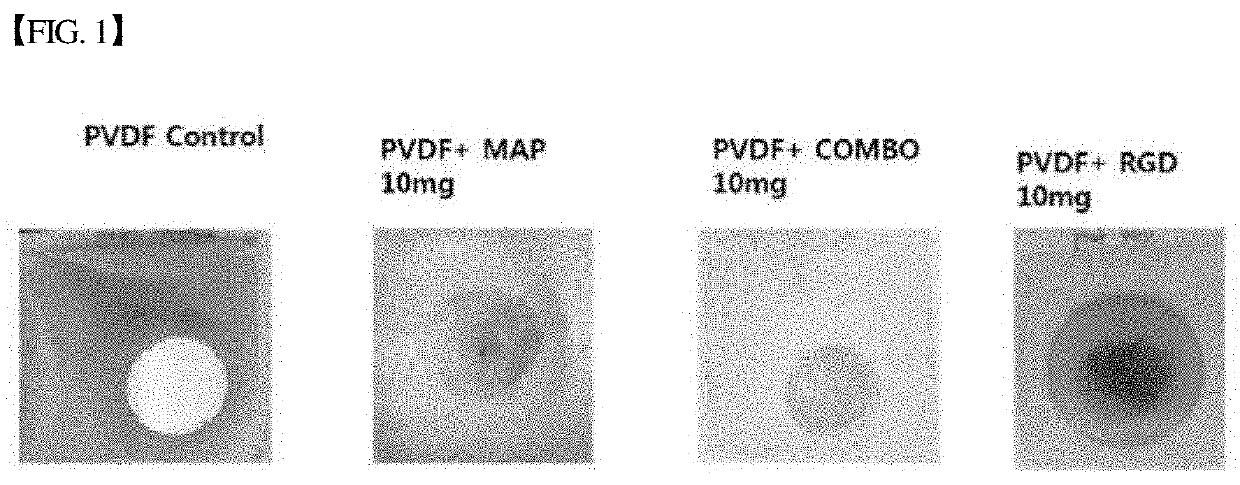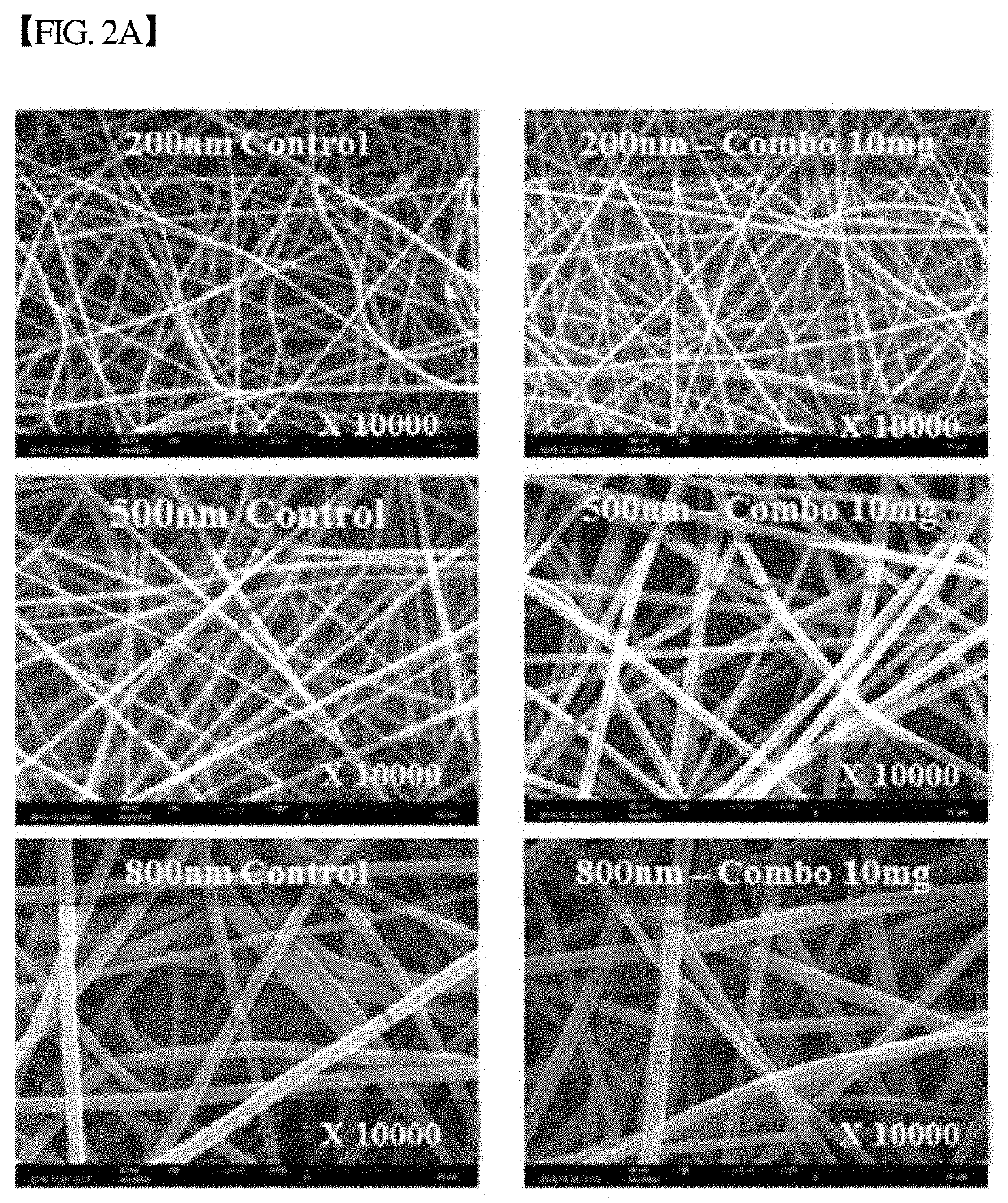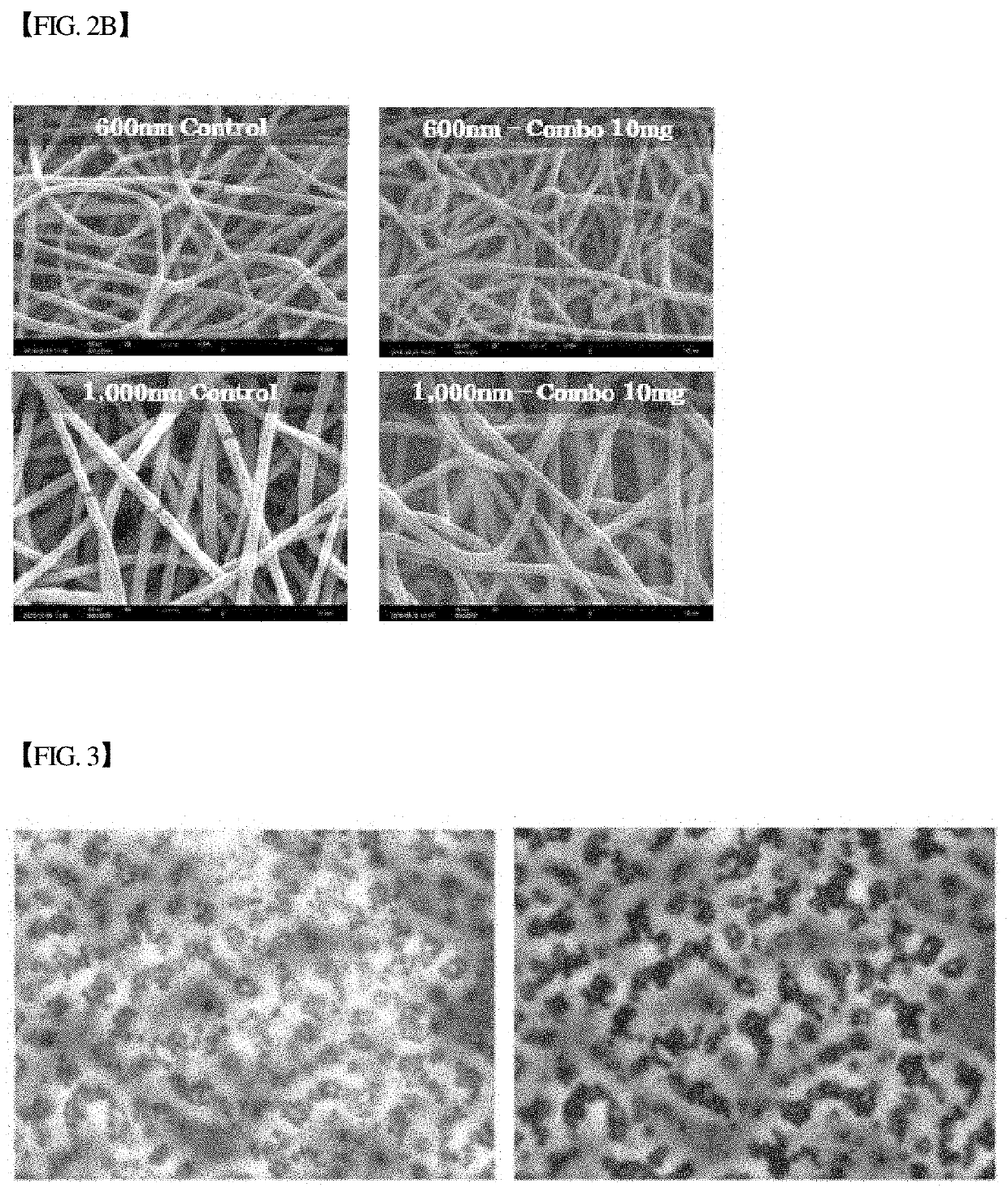Three-dimensional micro-environment structure for controlling cell behavior, three-dimensional surface for controlling cell behavior, and method for manufacturing array and three-dimensional micro-environment structure
a microenvironment and cell behavior technology, applied in the field of three-dimensional microenvironment structure, can solve the problem that conventional technologies do not create a microenvironment that induces combinatorial signaling pathways, and achieve the effect of accurate control of cell behavior
- Summary
- Abstract
- Description
- Claims
- Application Information
AI Technical Summary
Benefits of technology
Problems solved by technology
Method used
Image
Examples
example 1
ion of Peptide Motifs to Nanofiber Surface by Electrospinning
[0118]Experimental Method
[0119]1) Preparation of Electrospinning Solution: Each of four synthetic polymers, PVDF (average molecular weight: 200 kDa; purchased from Sigma Aldrich (St. Louis, USA)), PAN (average molecular weight: 200 kDa), PES, and PLA (average molecular weight: 200 kDa; purchased from Sigma Aldrich (St. Louis, USA)), was prepared at a concentration of 12 to 18 wt % in the solvent DMAc.
[0120]2) Next, the extracellular matrix mimetic MAPTrix™ (purchased from Kollodis Biosciences (North Augusta, S.C., USA)) was dissolved in a mixed solvent of water / DMAc, and then the synthetic polymer solutions of 1) were added thereto, thereby preparing electrospinning solutions having concentrations of 15 wt % and 18 wt %.
[0121]At this time, DMAc and THF were used as solvents, and the mixing ratio of the solvents was controlled to adjust the fiber diameter.
[0122]For example, in order to manufacture fibers having a fiber diam...
example 2
Membranes Having Controlled Fiber Diameters
[0132]Experimental Method
[0133]1) To control the nanofiber diameter, PVDF was selected as a representative, and PVDF copolymers miscible with the PVDF were used to prepare mixtures. As the PVDF copolymers, PVDF copolymers having molecular weights of 400,000, 600,000 and 650,000 were used to manufacture nanofiber membranes having various fiber diameters.
[0134]2) While the mixing ratio of the PVDF and the PVDF copolymer was changed from 1:1 to 1:2, 1:3, 1:4, 1:5, 1:6, 1:7, 1:8 and 1:9, the effect of the molecular weight and mixing ratio of the PVDF copolymer on the control of the diameter was observed.
[0135]The electrospinning procedure and conditions are the same as described in Example 1.
[0136]Experimental Results
[0137]The experimental results are shown in FIG. 2. FIG. 2A depicts photographs of nanofibers having fiber diameters of 200 nm, 500 nm and 800 nm, respectively, and FIG. 2B depicts photographs of nanofibers having fiber diameters o...
example 3
re of Nanofibers Containing Particles
[0140]Experimental Method
[0141]1) To introduce particles composed of an extracellular matrix mimetic onto the surface of nanofibers, sodium bicarbonate was dissolved in 1 mL of water to obtain 10 mM buffer solution (pH 6.5), and 10 mg of EDC (1-ethyl-3-[3-dimethylaminopropyl]carbodiimide hydrochloride) and 5 mg of S—NHS were dissolved in the buffer solution, thereby preparing an aqueous solution.
[0142]2) Next, 0.1 mg of a mussel protein with the fibronectin mimetic PHSRN-RGDSP peptide motif was dissolved in 1 mL of water, thereby preparing a reaction solution.
[0143]3) The EDC / S—NHS solution was added to a nanofiber membrane-coated micro well plate and incubated for 30 minutes so that the —COOH group of MAPTrix present on the nanofiber membrane surface was activated.
[0144]Thereafter, the reaction solution of 2) was added to the nanofiber surface so that it reacted with the —COOH group on the nanofiber surface to form particles.
[0145]Experimental R...
PUM
| Property | Measurement | Unit |
|---|---|---|
| Concentration | aaaaa | aaaaa |
| Concentration | aaaaa | aaaaa |
| Structure | aaaaa | aaaaa |
Abstract
Description
Claims
Application Information
 Login to View More
Login to View More - R&D
- Intellectual Property
- Life Sciences
- Materials
- Tech Scout
- Unparalleled Data Quality
- Higher Quality Content
- 60% Fewer Hallucinations
Browse by: Latest US Patents, China's latest patents, Technical Efficacy Thesaurus, Application Domain, Technology Topic, Popular Technical Reports.
© 2025 PatSnap. All rights reserved.Legal|Privacy policy|Modern Slavery Act Transparency Statement|Sitemap|About US| Contact US: help@patsnap.com



